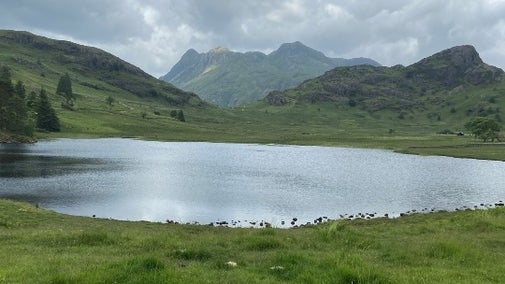Stickle Tarn trail
Lake District
This steep out-and-back path follows the Stickle Ghyll stream all the way up to Stickle Tarn, with striking views across Great Langdale. Take a breather to wonder at dramatic waterfalls and rock pools cut into the mountainside.
Near to
The LangdalesStart point
Stickle Ghyll car park, grid ref: NY294065Trail information
*Steep, well-defined stone path with some short, easy scrambles. For further details, please see Terrain section.
**Route unsuitable for people with limited mobility. Accessible facilities and trails nearby. For further details, please see section marked Access.
***Dogs welcome on leads. For futher details, please see section marked Facilities.
Rocky and uneven terrain
The stone path is well-maintained with some easy rocky scrambles, but it can be slippery in wet or wintry weather. Please take care with your footing and wear suitable footwear for the conditions.
More near here
Mickleden Valley trail
Explore an easy route along the valley floor of Mickleden in the Langdales, taking in Neolithic history, looming crags and spectacular views of the Langdale Pikes.

Blea Tarn trail
Surround yourself with views of the Langdale Pikes and other Lake District fells, without the tough climb, as you explore tranquil Blea Tarn on this easy, well-made trail.

High Close tree trail
A 1.2-mile walk around the High Close estate that takes in many of the rare and endangered conifer trees planted here by Edward Wheatley-Balme during the 19th century.

Langdale Valley cycle trail
Take a 11-mile cycle trail through Langdale Valley with views and opportunities to stop for refreshments along the way.

Get in touch
Great Langdale, near Ambleside, Cumbria, LA22 9JU
Our partners

We’ve partnered with Cotswold Outdoor to help everyone make the most of their time outdoors in the places we care for.
You might also be interested in
Walking
Explore some of the finest landscapes in our care on coastal paths, accessible trails, woodland walks and everything in between. Find the best places to walk near you.

Walking in the Lake District
From gentle ambles to more challenging hikes, these are some of the best walks to explore the heart of the Lake District.

Cotswold Outdoor: our exclusive walking partner
Learn about the National Trust’s ongoing partnership with Cotswold Outdoor. Find out how they help us care for precious places and the exclusive discount available for National Trust supporters.

Staying safe at National Trust places
The special places in National Trust care sometimes come with a few risks for visitors, be it coastline or countryside. Find out how to keep safe throughout your visits.

Follow the Countryside Code
Help to look after National Trust places by observing a few simple guidelines during your visit and following the Countryside Code.

Things to do in the Langdales
Head to the Langdales for stunning walking and cycling trails and discover rare trees and shrubs from around the world at High Close Estate and Arboretum.





